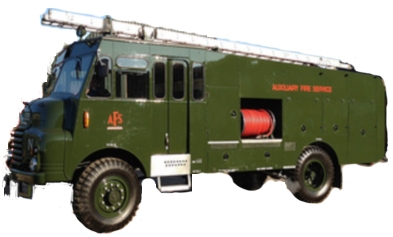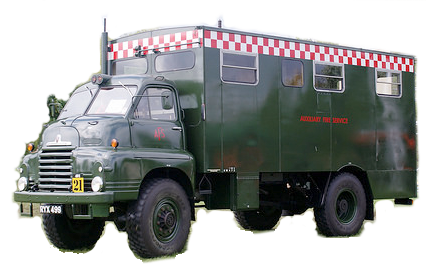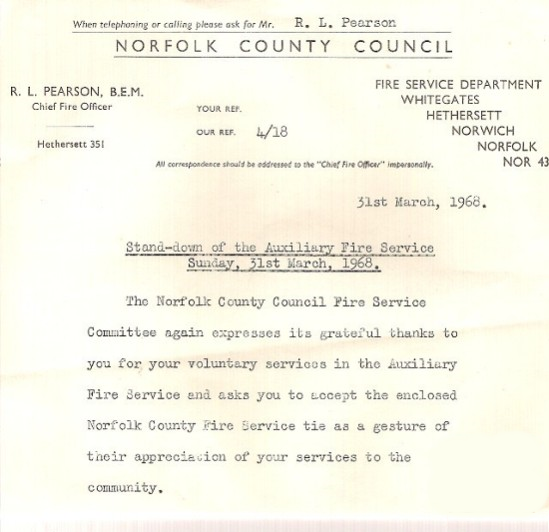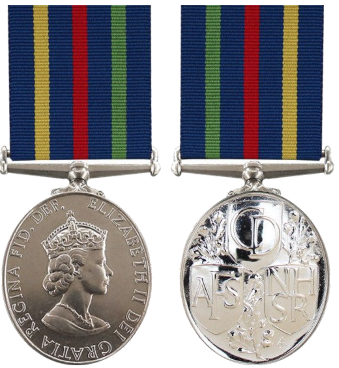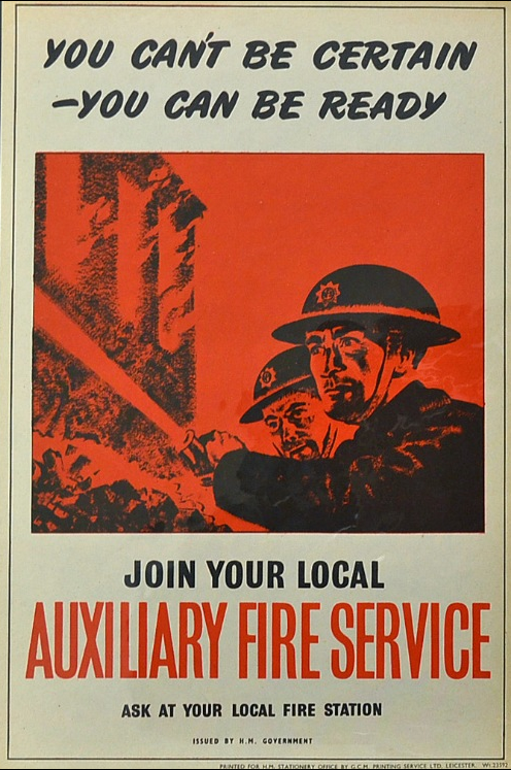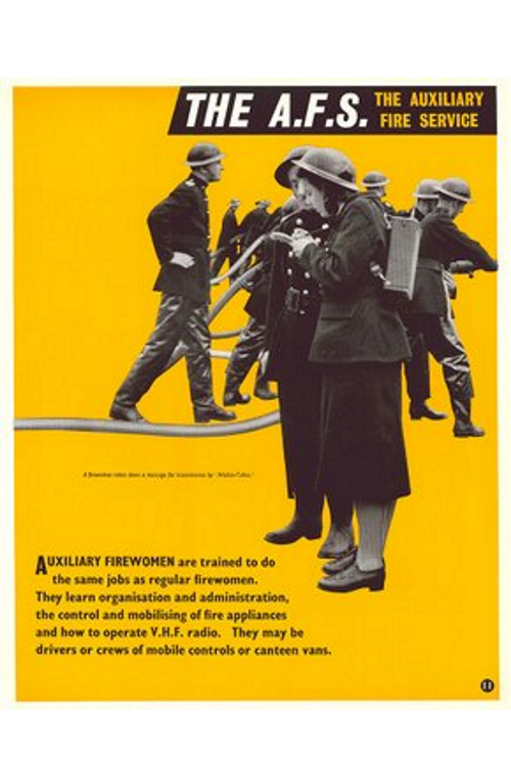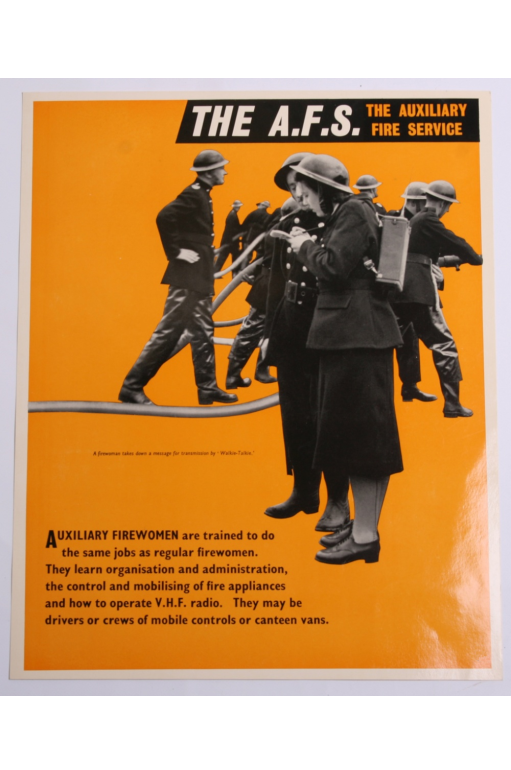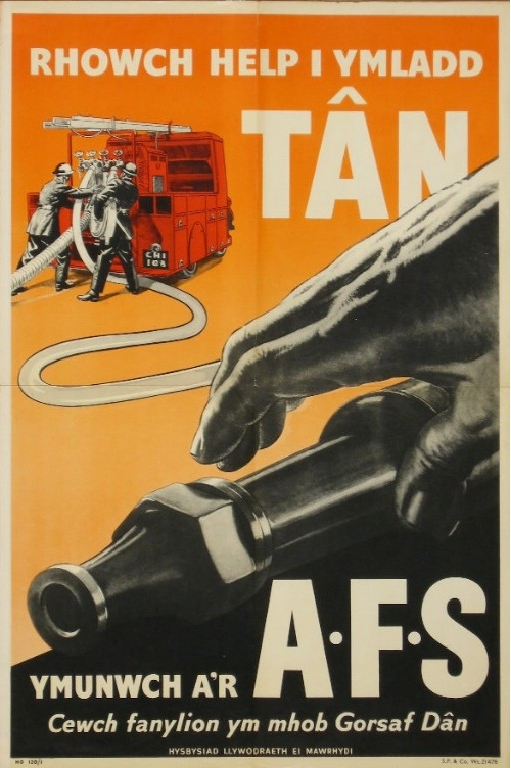Auxiliary Fire Service
The Auxiliary Fire Service (AFS) was first formed in the UK as part of Civil Defence Air Raid Precautions(ARP) just prior to the outbreak of WWII. Its role was to supplement the work of brigades at local level. In this task it was severely hampered by the incompatibility of equipment used by these brigades -- most importantly the lack of a standard size of hydrant connection.The Auxiliary Fire Service was reformed in 1948 alongside the Civil Defence Corps, starting initially with old National Fire Service equipment. However the role of the AFS was to provide mobile fire fighting columns that could be deployed to areas that had suffered a nuclear attack (it being assumed that the local fire fighting capability would most likely have been lost). The old equipment was not suitable for this task, so in the 1950s the AFS was re-equipped. This included 1,000 Green Goddess (Bedford RLHZ Self Propelled Pump) fire engines, Land Rovers, motorcycles and support vehicles such as pipe carriers, mobile kitchens, and foam and water carriers.
It was anticipated there would be some warning of the nuclear attack allowing some regular fire fighting equipment to join the AFS columns which would head to wherever they were required. These were substantial columns comprising many types of vehicles designed to be self-sufficient, so including motorcycles to go ahead and control traffic (e.g. AJS and Matchless), and carry messages, control vehicles such as the Land Rover and Austin Gipsy, field telephone equipment, fire fighting vehicles, pipe, water and foam carriers, as well as breakdown trucks and stores and catering. The AFS equipment was painted in British Standard 381C colour Deep Bronze Green, and carried large AFS door transfers.
Each fire station typically had an AFS division, and so AFS crews frequently attended fires and accidents alongside their regular colleagues. AFS personnel were trained in firefighting by their own officers and with assistance from full-time fire officers. Many were trained to the St John Ambulance Higher First Aid Certificate standard, often proving invaluable at major incidents involving injury.
The Cold War AFS hose fittings were aluminium rather than the brass which was common at the time, however the sizes were the same and were therefore interchangeable. Basic training took about 60 hours, the minimum age for joining was thirty.
Initially the AFS and regular fire services were to be kept separate for political reasons, and they were only meant to train and exercise together. This attitude made recruitment difficult initially. Fortunately it was soon realised that this was a serious waste of a significant resource, and soon the AFS could be seen taking a more active role in emergencies. Initially the recruitment target was to have two auxiliaries for every full-time fireman, and one for every part-time. These targets were never met.
The Civil Defence Long Service Medal
The Civil Defence Medal was instituted by HRH Queen Elizabeth II in March 1961 and awarded for 15 years continuous service in the Civil Defence Corps (CD), the Auxiliary Fire Service (AFS), the National Hospital Service Reserve (NHSR) and the United Kingdom Warning and Monitoring Organisation. Qualification was extended in 1963 to Civil Defence personnel in Gibraltar, Hong Kong and Malta. On the UK mainland, only members of the United Kingdom Warning and Monitoring Organisation continued to qualify after the 1968 disbandment, until it too was disbanded in 1992 (the Warning and Monitoring Organisation on the Channel Islands of Jersey continued until 2007). Prior service in the equivalent services of WWII counted when calculating total service. The medal was awarded in Hong Kong until the territory was transferred to China in 1997. The medal is still awarded to members of the Isle of Man Civil Defence Corps.
Auxiliary Fire Service Recruitment (1950) (© British Pathé)
Within a few years, AFS crews frequently attended fires and accidents alongside their regular colleagues. They provided significant assistance at some of the worst fires, such as that at Smithfield Market (1958) and at Barking wood yard (1960). AFS personnel were trained in firefighting by their own officers and with assistance from full-time fire officers. Many were trained to the St John Ambulance Higher First Aider Certificate standard - often proving invaluable at major incidents involving injury.
Green Goddess
From 1951 the AFS was re-equipped with 1,000 Green Goddess (Bedford RLHZ Self Propelled Pump) fire engines and a large number of other vehicles, including Land Rovers and Austin Champs & Gypsies, hose carriers, all painted Land Rover bronze green. The Green Goddesses were used in two forms, initially a 4x2 (two-wheel drive) version based on the Bedford SHZ chassis powered by a 6-cylinder 110-brake-horsepower (82-kilowatt) Bedford petrol engine, carrying 400 imperial gallons (1,800 litres) of water and a 1,000 imp gal/min (4,500 L/min) Sigmund FN4 centrifugal pump. Later versions were based on the Bedford 4x4 RLHZ chassis, with the same pump and 300 imp gal (1,400 L) water capacity. Their primary role was as a mobile pump, and they could combine to provide a pipe relay over great distances when connected using 6-inch (150 mm) hose, supplying 1,000 imp gal/min (4,500 L/min) from one location to another, often the seat of a major fire. An inflatable dam was often used as the source for the relay, usually fed by using several light portable pumps powered by Coventry Climax FWP engines. Water could be drawn from "open water" supplies (rivers, lakes or reservoirs) by a Transportable Water Unit more commonly known as "Bikini Units". These were floated on a raft so they could draw directly from a water and also use water under pressure to propel the raft.The only difference between the two types other than the obvious 4 or 2 wheel drive was the positions of the first aid hose reels and the 4x4 had a 300 gallon tank, the 4x2 had a 400 gallon tank. Pumps could combine to provide a pipe relay over great distances when connected using 6-inch hose, supplying large volumes of water from one location to another, often the seat of a major fire. An inflatable dam was often used as the source for the relay, usually fed by using several Light Portable Pumps powered by Coventry Climax FWP engines. These pumps were capable of supplying 1,000 imp gal/min (4,500 L/min) from one location to another."Bikini" Rafts
Light Portable Pumps were sometimes floated on a 'Bikini' inflatable raft so they could draw directly from a water supply such as a river. The complete Bikini unit comprised a Commer flat bed truck with three rafts carried on a rack on the cab roof, on the bed of the truck were six pumps, with hoses and fittings in lockers below the bed. In addition a launching ramp, trolley wheels and a hand-operated winch, together with ropes etc were provided.
Flint Auxiliary Fire Service Flint, Bikini Unit Drill, 1963
Mobile Columns
In common with other parts of civil defence, including the police and the Ambulance and Rescue sections of the Civil Defence Corps the AFS formed Mobile Columns, for deploymrnt to areas of particular need. A mobile column consisted of 125 vehicles and was crewed by 34 officers and 587 other ranks:
- 13 command and reconnaissance cars (Austin Gipsy or Land Rover Series 1)
- Communications unit - phone line layer (Austin Gipsy or Land Rover, both with a trailer and cable laying equipment). The field cable team comprised a leader plus two.
- Control Unit (Bedford RL)
- Mobile Workshop
- Mobile Canteen
- 5 Transportable Water Units, known as "Bikini Units" (Commer Q4)
- 57 General purpose - 3 ton
flatbed trucks (Bedford RL and Commer Q4) used as
- Hose layers.
- Pipe carriers.
- Ramp, dam and hose carriers.
- Personnel carriers.
- Petrol carriers.
- Clothing carriers.
- Recovery Vehicle (Bedford RL)
- 30 Self propelled pumps (Bedford "Green Goddess")
- 18 Motorcycles (Matchless and BSA)
The purpose of the column was to be essentially autonomous to a large degree, they could pump vast quantities of water from a remote water supply (such as a river, lake, canal or estuary) up to 20 miles away to a burning city, (900 gallons (or 4 tons) a minute, or nearly 6,000 tons of water a day. They carried 20 miles of 6-inch hose, and a further 20 miles of 3-inch delivery hose, and enough petrol to run 30 Goddesses for a week and the firefighting equipment to deliver this water around an area to burning buildings. They carried pipe bridges to get the hose over roads, and enough food and clothing for 620 men for a week, portable pumps to get water from the most inaccessible places. A communication system that would work over 20 miles a mixture of field telephones and VHF radios. The mobile workshop was capable of carrying out the majority, if not all, faulty equipment.
Mobile Fire Column - First Exercise (1956) (©British Pathé)
Disbandment
When the AFS was disbanded in 1968, the 4x2 Green Goddess units were auctioned, but the 4x4 version and Land Rovers and Austin Gypsies were mothballed against some future emergency. Local authority fire brigades could borrow Home Office vehicles to meet exceptional needs, and 500 Green Goddesses were brought out of retirement during the drought of 1976. The government used Army and Royal Navy personnel to man and operate fire appliances during the firemen's strikes, including Home Office equipment brought out of storage. Although they had been stored all over the UK, from 1992 the Green Goddess pumps were all relocated to the large TNT Truck Care depot in Marchington, Staffordshire. In 1997 a total of 96 low-mileage Austin Gypsies were auctioned by the Home Office at Measham, and the Green Goddesses and remaining Gypsies were sold in 2005, many going to fire brigades in developing countries, particularly in Africa, some to preservation.
